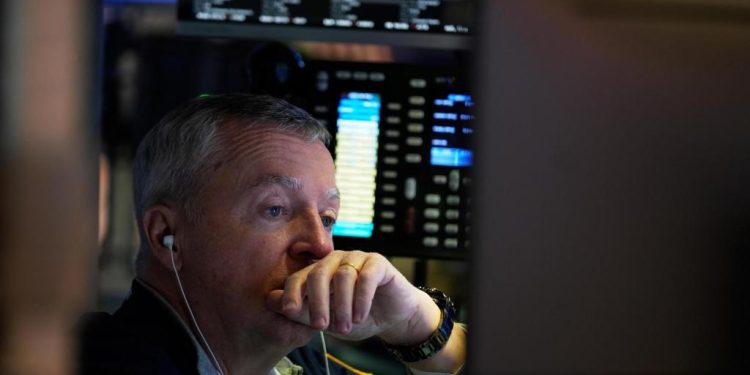By Stan Choe and Alex Veiga, Associated Press
New York (AP) – Wall Street could soon be in the claws of another lower market, because the Trump administration rate fuels the price fears that additional taxes on goods imported from the whole world divide the world economy.
The last bear market occurred in 2022, but this decrease is more like the sudden and turbulent index of 2020, when the S&P 500 reference index dropped by 34% in a period of one month, the shortest bear market of all time.
Here are some common questions in the bear markets:
Why is it called a lower market?
A lowering market is a term used by Wall Street when an index such as the S&P 500 or the industrial average of Dow Jones dropped by 20% or more compared to a recent summit for a sustained period.
Why use a bear to refer to a market crisis? Hibernate door, they therefore represent a stock market market that withdraws. On the other hand, the nickname Wall Street for a booming market is a bull market, because the bulls are charged.
The S&P 500, the main health barometer of Wall Street, fell 1.2% in trading on Monday afternoon. It is now 18.4% below the top of all time it takes place on February 19.
The Dow Industrials dropped by 1.8%, and the Nasdaq composite heavy with technology, which was already on a lower market, dropped by 0.9%.
The most recent bear market for the S&P 500 took place from January 3 to October 12 in 2022.
What bothers investors?
The trade war has increased fear and uncertainty on Wall Street on how businesses and consumers will react.
President Donald Trump followed pricing threats last week by declaring a 10% reference tax on imports from all countries and higher rate rates on dozens of nations that execute trade surpluses with the United States.
The global markets cried the next day, and the sale deepened after China announced that it would retaliate with rates equal to those of the United States
Prices cause economic pain in part because they are a tax paid by importers who are often transmitted to consumers, adding to inflationary pressure. They also cause business partners in retaliation, which can harm all the savings involved.
Import taxes can also cause economic damage by complicating the decisions that companies must make, including suppliers to use, where to locate factories and prices to be charged. And this uncertainty can lead them to delay or cancel investments that help stimulate economic growth.
The prices come at a time when the American economy already shows signs of slowdown. The markets also fear that prices can feed inflation, which recently checked above.
How long do it take for authorization markets and how depth do they?
On average, the bear markets took 13 months to go from one peak to another and 27 months to return to the scale at least since the Second World War. The S&P 500 index dropped an average of 33% in the bear markets at that time. The largest decrease since 1945 occurred in the 2007-2009 bear market, when the S&P 500 dropped by 57%.

History shows that the faster an index is entering a lower market, the more deep they tend to be. Historically, the actions took 251 days (8.3 months) to fall on a lower market. When the S&P 500 dropped by 20% to a faster clip, the index has an average of a loss of 28%.
The longest bear market lasted 61 months and ended in March 1942. It reduced the 60%index.
When is a lower market finished?
Generally, investors are looking for a 20% gain in a low point as well as gains supported over at least a six -month period. It took less than three weeks for shares to increase by 20% compared to their lowest in March 2020.
Should investors sell now?
If you need money now or want to lock the losses, yes. Otherwise, many advisers suggest crossing the ups and downs while remembering that swings are the price of admission for stronger yields that actions have provided in the long term.
Although discharge stocks that would stop bleeding, it would also prevent any potential gain. Many of the best days for Wall Street occurred either on a bear market, or just after an end. This includes two separate days in the mid-2007-2009 bear market when the S&P 500 increased by around 11%, as well as jumps better than 9% for and shortly after the 2020 bear market.
The advisers suggest putting money in actions only if it will not be necessary for several years. The S&P 500 has returned from each of its previous bear markets to possibly reach another summit of all time.
The drop in the decade for the stock market after the 2000 burst of the Dot-Com bubble was a notoriously brutal section, but the shares were often able to regain their heights in a few years.
Veiga reported to Los Angeles.
Originally published:
California Daily Newspapers


